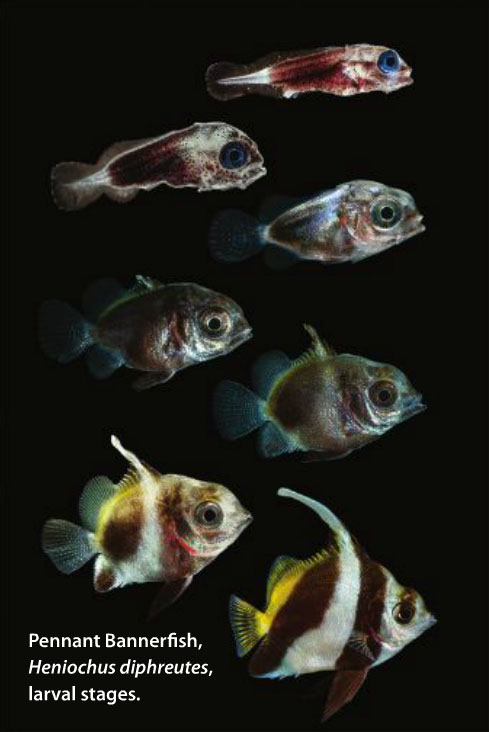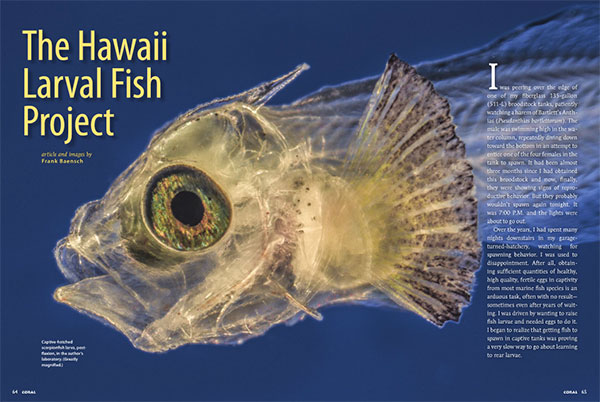The following excerpt is a selection from “The Hawaii Larval Fish Project” by Frank Baensch. Get it now in the March/April 2014 issue of CORAL Magazine
BUTTERFLY BREAKTHROUGH
Almost two years after starting this project my plane touched down at the Honolulu airport. Claudia had spent the past 2 weeks tending to the needs of my fishes. I had been off-island on a boat with no phone contact, and was very eager to find out how the little ones were doing—especially Sunny. Like Jack, Sunny was a very special fish.
As the plane’s wheels hit the tarmac I dialed Claudia’s number. She picked up and after a short greeting I quickly got to the point. “So, how’s Sunny doing?” There was silence on the other end. Then she responded in a triumphant voice: “He’s racing around the tank eating like a champ.”

The larval development of the Schooling Bannerfish, Heniochus diphreutes, as documented by Frank Baensch
Sunny was 92 days old. He had been collected in the 60th egg tow of the project and belonged to one of the fish families I’d been working on since this project started. Normally I would never have left such an important fish, but the long duration of the larval stage had been a surprise. During my 2-week absence Sunny had started his transition into a juvenile…a juvenile Pennant Bannerfish (Heniochus diphreutes). Sometimes called the False Moorish Idol, this species is actually a butterflyfish and a member of the Chaetodontidae.
Butterflyfish larvae had been identified in my rearing tanks many times throughout the project. Fortunately, the larvae were quite easy for me to distinguish early on from other families (within the first 10 days after hatching), because their morphology and behavior were similar to those of marine angelfish larvae (Centropyge). Further, the body color of Chaetodon larvae is yellow and that of Heniochus diphreutes larvae is very dark. Unlike the surgeonfish, triggerfish, wrasse, and scorpionfish larvae I’d worked on, which require tiny foods (50–60 microns in size) at first feeding, first-feeding butterflyfish larvae can capture 60–80-micron nauplii. They also survive quite well in small rearing systems. In fact, their rearing requirements appear similar to those of Centropyge.
Unfortunately, chaetodontid larvae become more fragile and undergo critical periods of high mortality in the later stages. Heniochus diphreutes, Forcipiger flavissimus, and several Chaetodon spp. were all reared up to 7–8 weeks numerous times, but never beyond. This changed with the 60th tow of the project (and the last tow of 2013), when I finally collected enough eggs to bring 10 Heniochus larvae through flexion (20–25 dph). Sunny survived the 100-plus-day larval period. As of January 1, 2014, he (actually, she) is a beautiful 125-day juvenile thriving on pellets and newly hatched brine shrimp in my grow-out system.
Like what you read so far? The full article is available in the March/April 2014 issue of CORAL Magazine
(Buy A Back Issue | Subscribe Now)
Keep up with the future advances at The Hawaii Larval Fish Project Blog.
On Fishbase – Heniochus diphreutes
Images: Frank Baensch / Blue Reef Photography






Trackbacks/Pingbacks